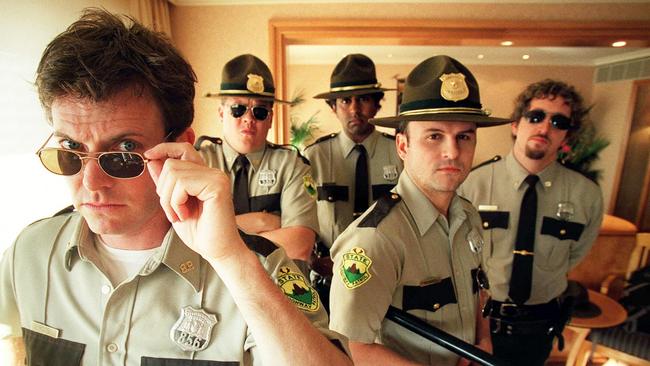Crowd-funding grew by $5.1 billion last year but an expert says it’s not all success stories
CROWD-FUNDING has raised money for the Super Troopers movie sequel and a table-salt firing shotgun but we never hear about the ideas that fail.

CROWD-FUNDING has helped get the sequel to a cult classic off the ground and make one man’s dream of a commercially-viable flame-thrower possible. And that’s just in the last week.
Other bizarre crowd-funded projects include a pizza memorabilia museum and a shotgun that fires table salt.
It is the democratisation of philanthropy and it is happening before our eyes. It seems like anything is possible but an expert says there are pros and cons and obvious risks involved.
This is what you should know before jumping on the crowd-funding bandwagon.
WHAT IS IT?
Crowd-funding, a phenomenon that went mainstream in 2012, is a platform that combines the people power of the internet and social media with creative, business, or philanthropic ideas. It essentially allows an idea to get off the ground when the idea’s creator has no capital.
The basic premise is this: take an idea that people can get behind, put a call out for contributions, wait. Crowd-funding uses websites like Kickstarter, Pledgie and IndieGoGo to channel contributions and keep donors in the loop.
So popular is the crowd-funding movement that last year alone it grew by over $5.1 billion worldwide. But it’s not all glitz and glamour. There’s a real risk an idea will sink or that donors never see the end result.

WHAT ARE THE ISSUES?
Dr Wendy Scaife — a woman who herself has invested in crowd-funding projects but spends most of her time researching the subject for the Queensland University of Technology — says there are real problems with the basic crowd-funding model.
She said the Donor Bill of Rights, a document created in the US to hold crowd-funders accountable, should be replicated in Australia.
“We’ve seen plenty of ‘scampaigns’,” she said.
“What the Donor Bill of Rights does is establish the core principles of crowd-funding including disclaimers in case something goes wrong and even something called the ‘lemon policy’ for when ideas just don’t translate to success, despite the financial backing of strangers.”
The document states donors have the right to “be informed of the organisation’s mission and identity”, “be assured their gifts will be used for the purposes for which they were given” and “be assured that information about their donations is handled with respect”.
Dr Scaife said there is an expectation that crowd-funding sites do due diligence but that is often not the case in Australia.
“What you’ll often see is there are a lot of promises about the donors receiving regular reports and updates but once the money comes in the effort sometimes stops.”
Kickstarter doesn’t guarantee a project will work and says it is up to the backers to determine the validity of each project.

WHAT WORKS AND WHAT DOESN’T?
It’s hard to know exactly what works and what doesn’t work. Forbes lists the most successful projects of the past 12 months as an esky that includes a built-in ice crushing blender, a card game called Exploding Kittens and the Veronica Mars movie project — a feature film that 91,585 funder poured almost $US6 million into. Other ideas fail miserably.
Dr Scaife said there are a number of things that make people donate and, equally, turn away.
“What we know people don’t like is a lack of personal connection or confidence in a project,” she said.
Dr Scaife said it is harder to get behind a project if it hasn’t already started but that once the wheels are in motion there is a sense of belonging that guides people to give.
“People really want that social kudos that means they can talk about being a part of the latest big thing,” she said.
“There’s also an addictive nature to helping someone get a break or giving somebody a go.”
She said behind the negative and potentially-dangerous crowd-funding model is a powerful message about giving.
“It’s not all about money,” she said. “When I hear about people crowd-funding food donations it’s clear that through that model we’re all giving more in our own small way.”




